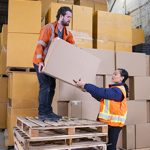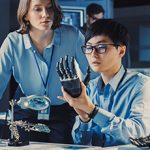From OSHA to COVID-19: 50 Years of Workplace Safety Innovation

This National Safety Month, Risk & Insurance® is taking a look at the past 50 years of workplace safety innovations.
From the birth of workplace safety with the formation of OSHA to the wearable technologies that will be the future of injury prevention, here’s what 50 years of innovation looks like.
1969-70: The Board of Certified Safety Professionals Is Created
In 1969 nine safety professionals banded together to form the Board of Certified Safety Professionals, a nonprofit that offers accrediting services and establishes standards in professional safety practice.
Their designation, the Certified Safety Professional (CSP) is considered one of the best among safety professionals.
1971: OSHA was Formed
Many consider the founding of the Occupational Health and Safety Administration (OSHA) to be the beginning of workplace safety in the United States.
Prior to OSHA’s founding accurate statistics on workplace fatalities and injuries were not kept, though it is estimated that 14,000 workers were killed on the job.
By 2009, 39 years after their founding, OSHA had reduced that number to 4,340, even though employment had nearly doubled.
1960-1990s: Manual-Handling Task Guidelines Developed
 Opened in 1954, Liberty Mutual’s Research Institute for Safety is responsible for many workplace safety innovations.
Opened in 1954, Liberty Mutual’s Research Institute for Safety is responsible for many workplace safety innovations.
Their Manual-Handling Task Guidelines were developed between 1960 and 1991 when the institute was under the leadership of Charles R. Williams, Ph.D. (1961-1964) and Allen Cudworth (1965-1990).
These guidelines were produced based on tables researchers developed that stated the “maximum acceptable weights and forces that workers can lift, lower, push, pull or carry without excessive fatigue.”
1975-80: Growth of Workplace Robotics Development
General Motors implemented the first robot in a manufacturing operation in 1962, kicking off a wave of innovation in workplace robotics through the 60s and 70s.
The latter half of the 70s alone saw the introduction of the first fully electrically driven robot, the PUMA robot arm and the first generation of dedicated arc welding robots.
1980s: Repetitive Stress Research
 In the 1980’s The Research Institute at Liberty Mutual began studying repetitive stress injured through a series of controlled experiments where participants performed simulated light assembly work, manual screw-driving, and knife-cutting tasks.
In the 1980’s The Research Institute at Liberty Mutual began studying repetitive stress injured through a series of controlled experiments where participants performed simulated light assembly work, manual screw-driving, and knife-cutting tasks.
This research would lead to the establishment of guidelines for the maximum acceptable forces for repetitive wrist motion and it would eventually result in Liberty Mutual’s 1994 Musculoskeletal Stress Measurement Kit.
1990: The ASSE Foundation Is Established
 In 1990 the professional society the American Society of Safety Engineers established a foundation for occupational safety, health and environmental development, research and education.
In 1990 the professional society the American Society of Safety Engineers established a foundation for occupational safety, health and environmental development, research and education.
The foundation funds scholarships, fellowships, research grants and internships.
2000: North American Occupational Safety and Health (NAOSH) Week Begins
ASSE and the Canadian Society of Safety Engineering (CSSE) started North American Occupational Safety and Health (NAOSH) Week in 200 to draw attention to the importance of workplace safety measures.
2001-2006: Quantitative Analysis Unit Formed
 The Quantitative Analysis Unit (QAU) was developed by Liberty Mutual’s Research Institute in 2001 to conduct research on occupational injury epidemiology.
The Quantitative Analysis Unit (QAU) was developed by Liberty Mutual’s Research Institute in 2001 to conduct research on occupational injury epidemiology.
Each year the QAU produces a ranking of the leading causes of disabling occupational injuries and illnesses in the United States called the Liberty Mutual Workplace Safety Index.
In 2006, the QUA was renamed the Center for Injury Epidemiology.
2008: The Birth of the Cobot
The first collaborative robot (cobot) was installed at Linatex in 2008. Linatex opted to place the robot on the floor, rather than caged behind a safety fence.
Cobots have since found numerous applications in manufacturing and other industries.
2016: Robotics Applications for Workplace Safety Expand
 In 2016, GM began testing a RoboGlove developed in conjunction with NASA that allows workers to reduce strain and improve their grip while constructing automobiles.
In 2016, GM began testing a RoboGlove developed in conjunction with NASA that allows workers to reduce strain and improve their grip while constructing automobiles.
The glove uses special sensors and tendon-like servos to increase the user’s gripping or lifting force.
2017: Technology Allows Employers Unprecedented Safety Transparency
 Innovative technology developers are giving employers and supervisors the power to drill down safety efforts to the individual level, with apps that alert workers to hazards and allow supervisors to address spot potential risks early.
Innovative technology developers are giving employers and supervisors the power to drill down safety efforts to the individual level, with apps that alert workers to hazards and allow supervisors to address spot potential risks early.
One example is altiumAi, whose app futureWork calculates a risk score for each worker that could help companies identify safety concerns.
It uses data, technology and AI to reduce injury risk and make workplaces safer.
2018-2019: Growth of Exoskeleton Adoption
Ford, BMW, Toyota and John Deere have all started using exoskeletons in some of their factories.
The exoskeleton developed by Levitate Technologies, which MW, Toyota and John Deere are using, offers what feels like gentle support at the elbows to help workers reach overhead, leading to a 20% reduction in muscle load in some cases.
At Ford factories in Spain, an exoskeleton is being used to increase the endurance, rather than the strength of older workers.
2020: New Technologies Could Allow Companies to Reopen After COVID-19
With defeating the COVID-19 pandemic everyone’s top priority, it’s no surprise that many of 2020’s workplace health and safety innovations are centered on detecting and preventing the spread of the virus.
Thermal cameras that detect elevated temperatures, wrist devices that buzz if you’re standing closer than 6 feet to another co-worker and video analytics that detect mask-wearing violations could all be the reality when people return to the office. &










